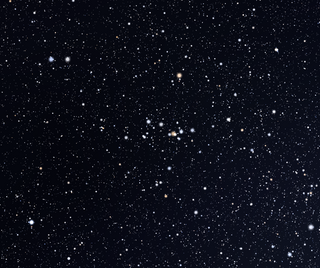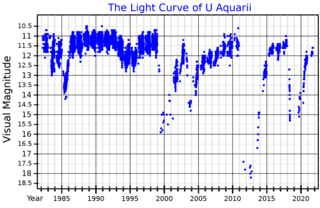
Corona Borealis is a small constellation in the Northern Celestial Hemisphere. It is one of the 48 constellations listed by the 2nd-century astronomer Ptolemy, and remains one of the 88 modern constellations. Its brightest stars form a semicircular arc. Its Latin name, inspired by its shape, means "northern crown". In classical mythology Corona Borealis generally represented the crown given by the god Dionysus to the Cretan princess Ariadne and set by her in the heavens. Other cultures likened the pattern to a circle of elders, an eagle's nest, a bear's den, or even a smokehole. Ptolemy also listed a southern counterpart, Corona Australis, with a similar pattern.

R Coronae Borealis is a low-mass yellow supergiant star in the constellation of Corona Borealis. It is the prototype of the R Cor Bor class of variable stars, which fade by several magnitudes at irregular intervals. R Coronae Borealis itself normally shines at approximately magnitude 6, just about visible to the naked eye, but at intervals of several months to many years fades to as faint as 15th magnitude. Over successive months it then gradually returns to its normal brightness, giving it the nickname "reverse nova", after the more common type of star which rapidly increases in brightness before fading.

T Coronae Borealis, is a recurring nova in the constellation Corona Borealis. It was first discovered in outburst in 1866 by John Birmingham, although it had been observed earlier as a 10th magnitude star.
DY Persei variables are a subclass of R Coronae Borealis variables. They are carbon-rich asymptotic giant branch (AGB) stars that exhibit pulsational variability of AGB stars and irregular fades similar to R CrB stars.

Kappa Coronae Borealis, Latinized from κ Coronae Borealis, is a star approximately 98 light years away in the constellation of Corona Borealis. The apparent magnitude is +4.82 and the absolute magnitude is +2.35. It is an orange K-type subgiant star of spectral type K1IV, meaning it has nearly completely exhausted its hydrogen supply in its core. It is 1.32 times as massive as the Sun yet has brightened to 11.6 times its luminosity. Around 2.5 billion years old, it was formerly an A-type main sequence star.

An R Coronae Borealis variable is an eruptive variable star that varies in luminosity in two modes, one low amplitude pulsation, and one irregular, unpredictably-sudden fading by 1 to 9 magnitudes. The prototype star R Coronae Borealis was discovered by the English amateur astronomer Edward Pigott in 1795, who first observed the enigmatic fadings of the star. Only about 150 RCB stars are currently known in our Galaxy while up to 1000 were expected, making this class a very rare kind of star.

DY Persei is a variable star and carbon star in the Perseus constellation. At maximum it is 11th magnitude and at its faintest it drops to 16th magnitude. DY Persei is the prototype of the very rare DY Persei class of variables that pulsate like red variables but also fade from sight like R Coronae Borealis variables.

S Coronae Borealis is a Mira variable star in the constellation Corona Borealis. Its apparent magnitude varies between 5.8 and 14.1, with a period of 360 days—just under a year. Within the constellation, it lies to the west of Theta Coronae Borealis, and around 1 degree southeast of the eclipsing binary star U Coronae Borealis.

U Aquarii, abbreviated U Aqr, is a variable star in the equatorial constellation of Aquarius. It is invisible to the naked eye, having an apparent visual magnitude that ranges from 10.6 down to as low as 15.9. Based on parallax measurements, the distance to this star is approximately 38 kly (12 kpc). In 1990, W. A. Lawson and associates provided a distance estimate of 43 kly (13.2 kpc) based on the assumption of a bolometric magnitude of −5. It appears to lie several kiloparsecs below the galactic plane, and thus may belong to an old stellar population.

UX Antliae is post-AGB star. It is an R Coronae Borealis variable star that has a base apparent magnitude of around 11.85, with irregular dimmings down to below magnitude 18.0.
Epsilon Coronae Australis, is a star system located in the constellation Corona Australis. Varying in brightness between apparent magnitudes of 4.74 to 5 over 14 hours, it is the brightest W Ursae Majoris variable in the night sky.
Theta Coronae Borealis, Latinized from θ Coronae Borealis, is a binary star system in the constellation Corona Borealis. It shines with a combined apparent visual magnitude of 4.13. There are two components: Theta Coronae Borealis A is of apparent magnitude 4.16, while Theta Coronae Borealis B lies around 1 arcsecond distant and has an apparent magnitude of 6.29. The system is located around 375 light-years from Earth, as estimated from its parallax of 8.69 milliarcseconds. It is estimated to be 85 million years old, with the primary star expected to remain on the main sequence burning its core hydrogen for another 75 million years and the secondary around 500 million years. Both stars will cool and expand once their core hydrogen is exhausted, becoming red giants.
Delta Coronae Borealis, Latinized from δ Coronae Borealis, is a variable star in the constellation Corona Borealis. Its apparent magnitude varies regularly between apparent magnitude 4.57 and 4.69, and it is around 170 light-years distant.

RY Sagittarii is a yellow supergiant and an R Coronae Borealis type variable star in the constellation Sagittarius. Although it ostensibly has the spectrum of a G-type star, it differs markedly from most in that it has almost no hydrogen and much carbon.
Z Ursae Minoris is a carbon star and R Coronae Borealis variable in the constellation Ursa Minor.
RS Telescopii, abbreviated RS Tel, is a variable star in the southern constellation of Telescopium. It is a dim star with an apparent visual magnitude of 10.67, which is much too faint to be visible without a telescope. The variability of this star was discovered by Evelyn F. Leland and announced by Edward C. Pickering in 1910. It was first studied by Cecilia H. Payne in 1928 at the Harvard College Observatory.

V Coronae Australis is a R Coronae Borealis variable star in the constellation Corona Australis. These are extremely hydrogen-deficient supergiants thought to have arisen as the result of the merger of two white dwarfs; fewer than 100 have been discovered as of 2012. V Coronae Australis dimmed in brightness from 1994 to 1998.

V Coronae Borealis is a Mira-type long period variable star and carbon star in the constellation Corona Borealis. Its apparent magnitude varies between 6.9 and 12.6 over a period of 357 days

W Coronae Borealis is a Mira-type long period variable star in the constellation Corona Borealis. Its apparent magnitude varies between 7.8 and 14.3 over a period of 238 days.

S Apodis is an R Coronae Borealis variable star located in the far southern constellation Apus. These are extremely hydrogen-deficient supergiants thought to have arisen as the result of the merger of two white dwarfs; fewer than 100 have been discovered as of 2012. Located around 13,000 light-years distant, it shines with a luminosity approximately 960 times that of the Sun and has a surface temperature of 3916 K.













